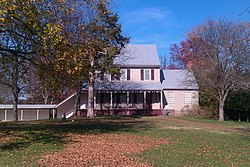Richard Bland Lee
Richard severely curtailed tobacco production in favor of more sustainable crops, including wheat, corn, rye, and barley. This reduced the soil depletion inherent to tobacco production, and allowed for the practice of crop rotation. He also planted fruit orchards, including peach and apple trees, which he used to produce spirits. In 1801 Richard constructed a dairy, which ran primarily under the supervision of his wife Elizabeth Collins Lee.
After his election to the United States Congress in 1789, and for most of the next five years, Richard turned day-to-day management of his estate over to his brother Theodorick, who supervised spring planting and fall harvest. Theodorick also managed the collection of rent from tenant farmers and the construction of the large house Richard had planned for the estate, on which construction had begun in 1794. Before he left for Congress in 1789, Richard had chosen the name "Sully" for his estate.
By 1811, having been drawn into heavy debt trying to aid his brothers, Henry Lee III and Charles Lee, extricate themselves from severe financial difficulties, Richard Bland Lee decided he could no longer sustain ownership of Sully. Accordingly, he decided to sell the plantation to raise cash to pay some of the debt. He sold Sully for $18,000 to his second cousin, Francis Lightfoot Lee II, son of Richard Henry Lee.
For several years after his purchase of Sully, Francis Lightfoot Lee II, [33] called F. L. by his family, was able to realize an annual profit of $1,500 to $2,500. At least part of that success was due to the "judicious system of husbandry" employed by F. L.'s wife Jane Fitzgerald Lee. Then in 1816, due to complications during the delivery of their fifth child Frances Ann Lee, Jane Fitzgerald Lee died. Four years later in 1820, F. L. had either a nervous breakdown or stroke. Unable to care for himself, he was committed to the Pennsylvania Hospital in Philadelphia in 1825.
Following the breakdown, Sully was placed under the administrative care of F. L.'s nephew Richard Henry Lee II. Richard Henry Lee II's management was marked by negligence and apparent apathy towards the dishonesty of managers who were embezzling money from the estate:
… mismanagement, having allowed an estate clear of debt, well stocked, well arranged under a good system as it had been for years' according to 'the universal belief and opinion of all friends, connections and neighbors' to be 'wasted and the debts lost.' ... Colonel W.C.B. Butler replaced Richard Henry Lee [37] as the 'Committee' for the Estate on January 1, 1827, but Butler also proved unsatisfactory. On June 23, 1830 the county court ordered his removal and, 'for the safekeeping and good management' of the estate ...
Control of Sully was next placed in the hands of Colonel George Washington Hunter in 1830. Gamble claims, "in no hands ... would Sully fare as well as when it had been assiduously maintained by a single, devoted, industrious proprietor."
After their father's move to the Pennsylvania Hospital during the summer of 1825, F. L.'s children (with the exception of Samuel Philips Lee who had entered the Navy), were under the care of William Brent, Jr. and Winifred Brent. The Brents were relatives who had moved to Sully to care for the Lee children and to start at Sully, a "select seminary" for boys and girls.
During subsequent years, as the Lee children grew older they began to leave Sully. Samuel Phillps Lee had entered the Navy, and John Lee went to West Point. Arthur Lee moved west to the Ohio country, while his oldest daughter Jane Elizabeth Lee married Henry Tazewell Harrison in a sunrise ceremony at Sully on February 6, 1834. With his brothers-in-law absent from the estate, Harrison took over representing their interests with the appointed administrator, Colonel Hunter, whom he replaced on July 18, 1836. Finally, in 1838, after a bizarre period, in which the estate had ostensibly been sold to a buyer who was arrested in England prior to completing the purchase, Sully was sold to merchant William Swartwort.























